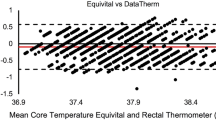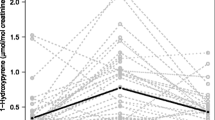Summary
Eight professional fire fighters participated in six fire fighting scenarios at a training facility. Data on heart rate (HR), rectal temperature (Tre), and skin temperatures at the chest and thigh were collected using a portable data acquisition system. Average HR ranged from 122 to 151 beats · min−1 during the six scenarios. Detailed analyses indicated that HR and Tre increases are related to both the physical and environmental stresses of the various activities carried out. The most demanding activity, that of building search and victim rescue, resulted in an average HR of 153 beats · min−1 and Tre rise of 1.3‡ C, while the least demanding activity, that of the crew captain who directs the fire fighting, resulted in an average HR of only 122 beats · min−1 and a Tre rise of only 0.3‡ C. This study shows that fire fighting is strenuous work for those directly entering a building and performing related duties, but that the physical demands of other activities are considerably less. The results further suggest that heat strain injuries in fire fighters could perhaps be reduced by rotating duties frequently with other crew members performing less stressful work.
Similar content being viewed by others
References
Abeles FJ, DelVecchio RJ, Himel VH (1973) A fire fighter's integrated life protection system. Phase I: Design and performance requirements. Grumman Aerospace Corp, New York
Astrand PO, Rodahl K (1977) Textbook of work physiology. McGraw-Hill, New York
Bancroft TA (1968) Topics in intermediate statistical method. Iowa State University Press, Ames, Iowa
Barnard RJ, Duncan HW (1975) Heart rate and ECG responses of fire fighters. J Occup Med 17: 247–250
Christensen EH (1953) Physiological valuation of work in Nykroppa Iron Works. In: Lloyd WF, Welford AT (eds) Fatigue. H. K. Lewis, London
Davis PO, Dotson CO, Santa Maria DL (1982) Relationship between simulated fire fighting tasks and physical performance measures. Med Sci Sports Exerc 14: 65–71
Duncan HW, Gardner GW, Barnard RJ (1979) Physiolgical responses of men working in fire fighting equipment in the heat. Ergonomics 22: 521–527
Fanger PO (1970) Thermal comfort. McGraw-Hill, New York
Kanon E (1972) Ergonomics of heat and cold. Texas Rep Biol Med 33: 145–182
Lemon PWR, Hermiston RT (1977) The human energy cost of fire fighting. J Occup Med 19: 558–562
Maxfield ME, Brouha L (1963) Validity of heart rate as an indicator of cardiac strain. J Appl Physiol 18: 1099–1104
Author information
Authors and Affiliations
Rights and permissions
About this article
Cite this article
Romet, T.T., Frim, J. Physiological responses to fire fighting activities. Europ. J. Appl. Physiol. 56, 633–638 (1987). https://doi.org/10.1007/BF00424802
Accepted:
Issue Date:
DOI: https://doi.org/10.1007/BF00424802




